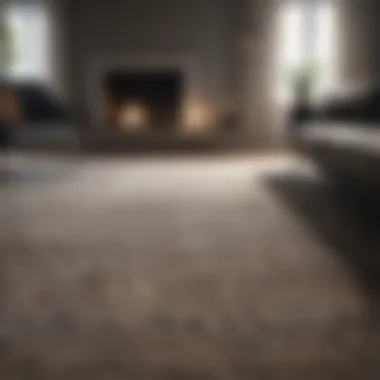Enhancing Living Rooms with Area Carpets


Intro
Area carpets are not merely decorative elements; they play a vital role in enhancing both the aesthetics and functionality of living rooms. For homeowners and renters alike, the right area carpet can unify a space, provide comfort underfoot, and add layers of warmth and interest. Understanding the nuances involved in selecting and styling these carpets is essential for creating an inviting environment.
This article will explore key aspects of area carpets, from choosing the right material to keeping in mind the latest trends and maintenance requirements. Homeowners will find useful tips that cater to different styles, ensuring that they can make informed decisions that reflect their personal taste and lifestyle needs.
Design Inspiration
Current Trends in Interior Design
Staying updated on current design trends can significantly influence your choice of area carpets. In recent years, minimalism and sustainability have gained prominence. Carpets made from natural fibers like wool, jute, and cotton are popular due to their eco-friendliness and texture.
Another emerging trend is the blending of patterns and textures. Layering different carpets can create depth and sophistication. Modern designs featuring geometric shapes and bold colors are becoming increasingly popular, allowing homeowners to make a statement. This trend invites creativity and personalization, enabling spaces to reflect individuality.
Color Palettes That Transform Spaces
Color plays an important role in setting the mood of a living room. Neutral shades like beige, gray, and cream often work well as a base, providing flexibility in decor choices. However, bold colors such as deep blues, vibrant greens, or rich terracotta can create focal points and energize a space.
When choosing a carpet, consider how the color complements existing furnishings.
- Neutral Colors: Enhance calmness and openness.
- Bold Hues: Draw attention and facilitate conversation.
- Warm Shades: Create a cozy atmosphere, furnished for relaxation.
Mapping out a color scheme before finalizing your area carpet choice can lead to harmonious and visually appealing results.
"The color scheme is the soul of a room, and area carpets can accentuate or shift this soul significantly."
In summary, area carpets can transform living rooms in various ways. As you explore the importance of style, material, and color, consider how these elements interact with your personal lifestyle. This will guide you toward selecting the perfect area carpet that not only enhances your space but also captures your unique aesthetic.
Understanding Area Carpets
Area carpets hold significant importance in home decor, especially in living rooms. They can enhance the aesthetic appeal of a space and serve practical purposes, which makes them an essential aspect of interior design. This section will discuss the definition, historical context, and purpose of area carpets, shedding light on their multifaceted roles in modern homes.
Definition of Area Carpets
Area carpets are defined as decorative pieces of textile flooring, typically not covering the entire floor but instead placed in specific areas of a room. Their size varies, and they can be square, rectangular, or even round. Generally, they are used to define spaces within larger areas, creating a cozy and inviting atmosphere. Unlike wall-to-wall carpeting, area carpets can be easily moved and replaced, making them versatile options for home decor.
Historical Context
The concept of area carpets has a long history, dating back hundreds of years. Early examples can be traced to Persia and China, where handwoven rugs were created for warmth and decorative purposes. These carpets were often crafted with intricate designs and vibrant colors. Over time, area carpets spread across different cultures, adapting to local styles and materials. In Western countries, their use became more prominent during the 19th century, with a growing appreciation for decorative textiles in interior design. This evolution reflects not only aesthetic preferences but also changes in social norms and the accessibility of materials.
Purpose and Functionality
Area carpets serve multiple functions in a living room. Their primary purpose is to enhance the visual appeal of a space. They can tie together a room's color schemes while adding texture and depth to the overall design. Additionally, these carpets provide practical benefits, such as warmth and noise reduction. They can also define seating areas within open floor plans, creating separation without the need for physical barriers. Homeowners can choose area carpets that reflect their personal style and fit the specific needs of their living space.
"Area carpets can transform a stark room into a warm and welcoming space, adding both beauty and functionality."
Overall, understanding area carpets gives valuable insights into how they can improve living spaces. By delving into their definitions, historical significance, and functional roles, one can appreciate their relevance in modern interior design.


Selecting the Right Area Carpet
Selecting the right area carpet is crucial for transforming a living space. It impacts both the aesthetics and functionality of the room. A well-chosen carpet can enhance the atmosphere, making it inviting and comfortable. Moreover, it plays a role in defining spaces within open-plan living areas. Therefore, understanding the different factors influencing selection, such as material, pile height, and size, is essential.
Material Choices
When it comes to area carpets, material selection is significant. Each type of material offers distinct benefits and drawbacks. Choosing the right one can influence the durability, comfort, and maintenance of the carpet.
Wool
Wool is a natural fiber known for its durability and resilience. It has excellent insulating properties, making it a warm choice for living rooms. Wool fibers are also naturally stain-resistant, which is a considerable advantage in high-traffic areas. One of the main features of wool is its ability to retain color well, resulting in vivid carpets that can last for years without fading. However, wool can be more expensive than synthetic options, and it may require special cleaning to maintain its condition.
Nylon
Nylon is a synthetic fiber favored for its strength and versatility. It is known for its ability to withstand wear and tear, making it suitable for busy households. Nylon carpets are also less prone to crushing, hence they maintain their look for longer. The key advantage of nylon is its affordability. However, it is not as environmentally friendly as natural fibers, and it may require chemical cleaning products to combat stains effectively.
Polyester
Polyester is another synthetic option that is often chosen for its soft texture and vibrant colors. It is generally cheaper than wool and nylon, making it a popular choice among budget-conscious homeowners. This material is also relatively easy to clean and resist stains. But one downside is that polyester carpets may not be as durable as wool and nylon. In high-traffic areas, they can show signs of wear more quickly.
Natural Fibers
Natural fibers, such as jute or sisal, offer a unique texture and are increasingly popular due to their sustainability. These materials are biodegradable and eco-friendly, appealing to environmentally conscious consumers. Natural fiber carpets provide a distinct aesthetic with a rustic charm. However, they can be more susceptible to stains and may require additional care to keep them looking their best. Overall, they are ideal for low-traffic areas and add a unique touch to living spaces.
Pile Height and Density
The pile height and density of an area carpet affect both comfort and appearance. A higher pile typically offers more cushioning, making it softer underfoot. However, it can also lead to more maintenance, as dirt tends to settle deeper into the fibers. In contrast, lower pile carpets are easier to clean, but may lack comfort. Denser carpets provide greater durability, whereas less dense options might feel less luxurious and are easier to flatten.
Size Considerations
Size is a vital factor when selecting an area carpet. A well-fitted carpet can enhance the overall look of a room, creating a harmonious design. Consider the dimensions of the furniture and the available space when making a choice. Large rugs can unify separate furniture pieces, while smaller rugs can create defined spaces within a room. It's crucial to measure the area where the carpet will be placed to ensure a proper fit.
Design and Aesthetic Impact
The design and aesthetic impact of area carpets in living rooms cannot be overstated. They serve as a focal point that ties together various elements of interior design. Unlike mere floor coverings, these carpets can influence the perception of space, texture, and warmth within the room. By carefully considering their design aspects, homeowners can greatly enhance the aesthetic appeal of their living areas.
Color Theory in Carpeting
Color plays a vital role in the overall look of a living room. Using the principles of color theory, individuals can select area carpets that convey desired emotions or complement existing decor.
- Warm Colors: Shades like reds, oranges, and yellows often create a sense of warmth and intimacy. Such shades can make a space feel more inviting.
- Cool Colors: Blues, greens, and purples tend to promote relaxation. They are ideal for living rooms that aim for a calming environment.
- Neutral Colors: Grays, whites, and beiges allow flexibility and can adapt to various design themes without overwhelming the senses.
Understanding how colors interact, especially with natural light, is essential. Different times of day can provide contrasting appearances of the same carpet color.
Patterns and Textures
The patterns and textures of area carpets offer another layer of design impact. Patterns can range from simple geometric designs to intricate floral motifs. Here, the choice is largely dependent on the overall theme of the living room.
- Geometric Patterns: These can impart a modern touch, adding a layer of sophistication while promoting a clean aesthetic.
- Traditional Patterns: Orientals and Persian designs bring a sense of history and can make a space feel more elegant.
- Textures: The texture of the carpet can influence both the visual and tactile experience. For example, a shag carpet creates a sense of coziness and can soften a room's look, while a flatweave may appear more contemporary and sleek.


In addition, textures can enhance comfort. For instance, a plush carpet can invite guests to sit on the floor, fostering a casual atmosphere.
Coordinating with Furniture
Coordinating area carpets with furniture is crucial to creating a harmonious living space. The right carpet can complement or contrast with furniture choices effectively.
- Color Coordination: The carpet should either match or complement the color of the furniture. This increases integration and visual flow.
- Style Matching: The style of the area carpet should reflect the furniture's design. A modern sofa pairs well with contemporary carpet styles, while a vintage-styled couch could benefit from a more traditional area rug.
- Proportion and Scale: Ensure that the carpet is sized appropriately in relation to the furniture. An oversized carpet can unify the space, while smaller carpets may delineate separate areas within an open-plan layout.
Tip: Always consider the visual weight of both furniture and carpeting. Heavy furniture paired with a delicate carpet can unbalance the entire aesthetic of the room.
Integrating Area Carpets into Your Living Space
Integrating area carpets into your living space is more than just an aesthetic choice; it significantly influences the overall ambiance and function of a room. When selected and placed correctly, area carpets can provide warmth, define spaces, and enhance the interior design of a living room. They serve as a unifying element, bringing together different furniture pieces and accessories under a single theme or color palette. This section focuses on specific elements, benefits, and considerations for incorporating area carpets effectively.
Layout Strategies
Defining Space
Defining space is vital in living room design. Area carpets can visually delineate zones within an open-plan layout, which is increasingly popular in modern homes. By placing a carpet under a coffee table or seating area, you can create a distinct space that feels cozy and inviting. This characteristic of area carpets is beneficial because it helps reduce any visual clutter and provides a grounded feeling to the room. A unique feature of defining space with area carpets is the variety of shapes and sizes available; whether rectangular, round, or irregular, there is a carpet suitable for any configuration. However, it is important to consider the overall size of the room to avoid overwhelming the space or making it feel disconnected.
Flow and Interaction
Flow and interaction refer to how movement through a living room is facilitated by the arrangement of furniture and carpets. Area carpets can enhance these aspects by providing a visual pathway that guides people around the space. They can create a sense of harmony, inviting engagement and conversation among guests. This characteristic makes area carpets an effective choice for both social gatherings and daily use. The unique feature of flow and interaction is that when placed strategically, carpets can soften transitions from one seating area to another. However, one should be cautious about how textures and colors interact with the rest of the room, as poor choices can disrupt the intended flow.
Layering Techniques
Layering techniques involve using multiple carpets in a single space to add depth and complexity to the design. This method is particularly appealing in larger living rooms or in settings where there may be a need to adjust mood or function. For instance, placing a larger neutral carpet as the base and adding a smaller, patterned rug on top can create visual contrast. This allows homeowners to both express their style and maintain practicality. Layering can also help to define different areas within a room, similar to the defining space strategy, but adds more texture and interest. This technique can result in a dynamic and inviting environment, though it requires a thoughtful selection of styles and colors to ensure cohesion.
Maintenance and Care
Proper maintenance and care of area carpets is crucial to prolong their lifespan and maintain their aesthetic appeal. An area carpet serves not just as a decorative element but also plays a significant role in the comfort of a living space. Regular cleaning and timely repairs can prevent dirt accumulation and damage that may require costly replacements. Understanding how to care for your carpets helps in maintaining their beauty and function over time.
Regular Cleaning Practices
Keeping area carpets clean is essential. Dust, dirt, and allergens can settle into the fibers, affecting both appearance and air quality. Here are some effective cleaning practices:
- Vacuum Regularly: Aim to vacuum your area carpet at least once a week. This helps to remove dirt and debris before it becomes ingrained in the fibers.
- Spot Clean: If spills occur, act quickly. Use a clean cloth to blot the area. Do not rub, as this can spread the stain. A mixture of mild detergent and water can be effective for many types of stains.
- Deep Cleaning: Schedule a deep cleaning periodically, ideally every 12-18 months. This can involve steam cleaning or using professional carpet cleaning services.
These practices not only keep the carpet looking good but also contribute to a healthier indoor environment.
Addressing Stains and Repairs
Stains are often inevitable but knowing how to handle them can minimize long-term damage to your carpet. Here are key tips for addressing stains and doing repairs:
- Identify the Stain Type: Different stains require different treatment methods. For example, oil-based stains need a different approach compared to water-based ones.
- Use the Right Products: Utilize materials specifically designed for carpet cleaning. Avoid harsh chemicals that can damage fibers and colors.
- Repair Methods: For damaged carpets, consider the following methods:
- Patch Repair: If a small section is damaged, cutting out that section and replacing it with a matching piece can be effective.
- Fraying or Loose Edges: A simple sewing can fix frays or unraveling edges.


As a homeowner or an interior design enthusiast, adhering to these maintenance tips maximizes the lifespan of your area carpet while sustaining its visual appeal. Taking the time to care for your carpets pays off in the long run, both practically and aesthetically.
Current Trends in Area Carpeting
In the realm of interior design, area carpets do not merely serve to fill a room with color and texture. They are vital components that can define aesthetics, enhance comfort, and create harmony in spaces. The modern homeowner is increasingly aware of how trends shift and adapt, and understanding current trends in area carpeting is crucial for making informed decisions. This discussion will center on three significant trends: the use of sustainable materials, the appeal of bold colors and patterns, and the movement towards multi-purpose usage.
Sustainable Materials
Sustainability is more than just a buzzword in today’s world; it is a necessity. With increased awareness about environmental impact, using sustainable materials in area carpets has gained prominence.
Materials such as organic cotton, jute, and bamboo are gaining traction. These options not only reduce the carbon footprint but also promote a healthier indoor environment. Many carpets made from recycled fibers combine durability with eco-friendliness, catering to a conscientious audience.
Furthermore, consumers tend to prefer brands that prioritize ethical sourcing and production practices. Investing in sustainable area carpets enhances one's home while contributing positively to the planet. Homeowners should seek carpets labeled with certifications such as Global Organic Textile Standard (GOTS) or Fair Trade, ensuring careful vetting of material origin and production methods.
Bold Colors and Patterns
The trend of bold colors and patterns in area carpets reflects a desire for self-expression in home decor. Bright hues and striking designs can transform an otherwise neutral room into a vibrant living space. Choosing a carpet in a vivid color or notable pattern allows homeowners to take risks with their decor, making a significant impact.
Such carpets serve as focal points within a room. For example, a geometric pattern may complement modern furniture, while a rich Persian design enhances a classic interior. Additionally, accessories can be coordinated to echo the carpet’s colors, fostering a cohesive aesthetic throughout the room.
Important Considerations:
- Contrast: Bold carpets can contrast with furniture styles, creating visual interest.
- Balance: Avoid overwhelming the space; balance is key.
- Durability: Ensure that the colors and patterns do not compromise the quality of the carpet.
Multi-Purpose Usage
As homes evolve into multifunctional spaces, the trend toward multi-purpose usage of area carpets has emerged. It is common for living rooms to shift between spaces for relaxation, entertainment, and work.
Area carpets now need to accommodate these varied functions. For instance, a durable and easy-to-clean carpet is ideal in an area where children play or where frequent gatherings occur. Moreover, many homeowners are opting for carpets that serve as delineators in open-plan layouts, helping to define specific areas while maintaining an open feel.
Key Benefits of Multi-Purpose Carpets:
- Versatility: Easily adaptable for different occasions.
- Space Efficiency: Helps maximize usable space in smaller homes.
- Style Coordination: Can blend easily with various decor styles, facilitating personalization.
The Role of Area Carpets in Interior Design
Area carpets are much more than mere floor coverings; they are integral components of interior design, shaping the look and feel of a space. Their presence can transform a room by adding layers of style, texture, and comfort. For homeowners and design enthusiasts, understanding the role of area carpets is crucial in creating environments that reflect personal taste while being functional and inviting.
Creating a Cohesive Look
In interior design, harmony is paramount. Area carpets contribute to a cohesive look by tying together elements of decor within the living space. They help establish a focal point and can enhance the overall aesthetic by complementing the color palette and design theme. Choosing the right area carpet involves considering its style, color, and texture in relation to existing furniture and decor.
- Color Coordination: A well-chosen area carpet can highlight or contrast with wall colors and furniture upholstery. It's essential to reflect on how the carpet's hues will interplay with other elements in the room.
- Design Theme: Whether rustic, modern, or classic, the carpet should align with the chosen design theme. This creates a seamless flow that guides the eye throughout the room.
- Scale and Proportion: The size of the carpet should relate well to the room’s dimensions and furniture placement. A large area carpet can anchor a seating arrangement, while smaller rugs can help define individual spaces within an open plan layout.
All these factors combined can produce a harmonious living space where the area carpet plays a critical part.
Enhancing Comfort and Warmth
Comfort is a significant aspect of any living area, and area carpets excel at improving this quality. They provide a soft surface underfoot, which can be welcoming, especially in cooler climates. The choice of materials, pile height, and density influences the level of comfort that a carpet provides.
- Material Selection: Carpets made from natural fibers, like wool or cotton, often offer better insulation and a pleasant texture. Synthetic materials may provide durability and ease of cleaning, but might not always match the warmth of natural fibers.
- Pile Height: A thicker pile can provide more cushioning and insulation, making the space feel warmer and more inviting. Conversely, low-pile carpets are easier to clean and can be more suitable for high-traffic areas.
- Acoustic Properties: Carpets also offer sound absorption, reducing echo and noise in a room, which contributes to an overall sense of tranquility.
"An area carpet doesn't just cover the floor; it enhances comfort, beckons to be walked upon, and adds warmth to the livingspace."
In summary, area carpets are essential in interior design as they help create a cohesive visual narrative while providing comfort and functionality. Understanding their role assists in making well-informed choices that elevate any living area.



